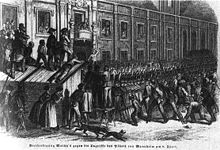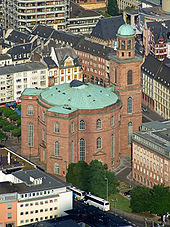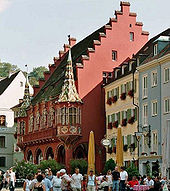Democracy Street


The road of democracy remembered as since September 7, 2007 Holiday - and also as a cultural street in south-west Germany , as in other tourist areas like the castles - or Baroque Road to the political awakening to democracy in the region in 1848 (German Revolution) . It is approx. 280 km long between Freiburg im Breisgau ( South Baden ) and Frankfurt am Main ( Hesse ). The subject of “democracy in Germany” is discussed in school lessons, but very few can look back on relatives in their own families who were involved in the efforts at that time. When visiting the places along the Straße der Demokratie , identification opportunities are offered that show that democracy is made by people and does not fall from the sky.
There are many monuments on it that remind of individual participants. However, some are more or less anonymous communal graves of the "insurgents" who were shot at the time. The word “Prussia”, on the other hand, still smacks of the intervention troops ( federal troops ) in Baden today . So far there are a total of 63 stations on this history route. Through a better didactic preparation of the museum , connections should be made comprehensible. The aim is to show what democracy meant in 19th century Germany.
Origin, special features
The project was initiated by the cities of Karlsruhe and Offenburg in 2005 and officially began on September 7, 2007 with the presentation of the travel guide Die Straße der Demokratie. A route guide on the trail of freedom in Hambach Castle. Uniform labeling and information transfer make it easier to keep an overview. The good experiences and knowledge gained at the 150th anniversary celebration in 1998 should not be lost. The participating locations decided in a long process for a new type of town twinning on a topic. Tourism marketing ( holiday route ) and political education will be combined in a previously unique form, across national borders, across a wide area in this new “road through history”.

From Frankfurt via Mainz and Mannheim to Lörrach the visitor can travel in the footsteps of the freedom movement - from the French Revolution to the Vormärz to the present day - in the German southwest and on the basis of buildings, museums, squares and other places of remembrance with one travel guide Get to know people and the common free-democratic traditions of a region. The bourgeois revolution in German history often appears in general as a national liberation struggle against the many monarchies - but it is always connected with the democratic movements of neighboring countries such as Switzerland and Austria and first and foremost in France with the February Revolution . This also repeatedly reminds people that German democracy is a (difficult) part of the history of Europe and cannot be viewed in isolation as a national survey. Conversely, today's Europe would be inconceivable without the personal commitment of many people in the 19th century - especially with the initially failed revolution of 1848/49.
Participating in the creation of the street of democracy are the memorial for the freedom movements in German history Rastatt , the Hambach Castle Foundation and the eleven cities of Bruchsal , Frankfurt am Main , Freiburg im Breisgau , Heidelberg , Karlsruhe , Mainz , Mannheim , Landau , Lörrach , Neustadt an der Weinstrasse and Offenburg , as well as the two state centers for political education in Baden-Württemberg and Rhineland-Palatinate . The first venue on the street was a future conference on September 7, 2007 at Hambach Castle.
Route overview, stations
From north to south, the route, which mainly runs through the Upper Rhine Plain , follows federal highways 9 , B 38 and B 36 . The region is also accessible through a dense network of cycle paths and public transport . At that time, the newly built Rhine Valley railway line was decisive for the war. Detours to the Oden , Black Forest and Alsace are also worthwhile in some places from a historical perspective. Below are some of the 63 stations with references to linked articles.
- Frankfurt - National Assembly , Paulskirche , on September 18, barricade fighting, Robert Blum , Heinrich von Gagern
- Mainz - The Younger Dalberger Hof was the scene of a high treason trial from 23 May to 8 June 1850 against 77 democrats . The city theater was the meeting place of the people and at the same time the headquarters of the vigilante group . In the main cemetery , the so-called Prussian monument commemorates the Prussian soldiers who died in the street fight on May 21st .
- Goddelau near Darmstadt: Büchnermuseum (Vormärz)
- Before and next to Frankfurt, Mannheim was a political and military center in the southwest - u. a. Barricade fighting on February 27, 1848, demands of the Mannheim people's assembly , place of activity of Karl Drais
- Heidelberg - Freedom and nationally minded students of the university campaigned with farmers and citizens against the positions of the reaction . The Heidelberg assembly was a meeting of 51 liberal and democratic politicians on March 5, 1848 in the "Badischer Hof" inn
- Kislau Castle , a former summer residence and bathing resort of the Prince-Bishop of Speyer , became a place of internment for the freedom fighters of Baden after the defeat in 1849, including many students from Heidelberg among the prisoners.
- Hambacher Schloss - 1832, Vormärz, first mass protest meeting of modern times in Germany, near Neustadt an der Weinstrasse
- Landau in what was then the Bavarian Palatinate - Konrad Krez , he too later an emigrant and then general of the Union Army in the USA
- Waghäusel - in the battle near Waghäusel the revolutionary army triumphed over Prussian troops (June 21, 1849, Ludwik Mierosławski - officer of Polish origin born in France and second in command of the revolutionary army in Baden)
- Karlsruhe - Baden Revolution , Karl Drais , other milestones are the Old Badische Ständehaus (1822, the first German parliament building ), 1864 the first German administrative court, 1893 the first German girls' high school and since 1951 the Federal Constitutional Court .
- Memorial site for the freedom movements in German history Rastatt - On July 23, 1849, the united revolutionary and parts of the regular Baden army surrendered here. (This museum was a source of ideas for the new street, initiated around 1980 by the then Federal President Gustav Heinemann )
- Offenburg - in the Salmen house, people's assemblies (e.g. the Offenburg assembly in 1848 ), Franz Sigel put together the Baden freischarians here .
- Freiburg - Barricade fighting against the Baden and Hessian federal troops on Easter Sunday, 1848. From 1946 to 1949, the historic department store on Münsterplatz was also the parliament building. On November 22, 1946, a democratic state assembly met in Baden for the first time since 1933 in the Kaisersaal. The French governor Pierre Pène handed over the independent leadership to the people. The assembly drafted the constitution, which was put to a vote on May 18, 1947. The Baden state parliament , elected at the same time as the referendum , met here on May 29 for its first session.
- Lörrach - The former Hirschen inn was a meeting place for the newspaper reading club. Gustav and Amalie Struve . Emma Herwegh , a Republican and the first female military leader in German history


Miscellaneous
- There is a regular local road of the same name, a rarity by the way, in Breitenworbis and Battern (district of Haynrode) . The rue de la démocratie is also not frequent in France , possibly because of the echo of the years after 1789 . Instead, there is often a rue de la République , where the term "republic" stands for ideals such as freedom and equality.
- Incidentally, with the "Road of Remembrance and Human Rights" ( Chemin de la memoire et des droits de l'homme ; with a focus on the years 1943–1944) there is a similar project in Alsace , supported by private individuals and municipalities. that is preparing to cross the Rhine at Rastatt .
- By Dani Karavan was in Nuremberg in the German National Museum in the artwork " Way of Human Rights " ( "Way of Human Rights" ) designed.
- The Neue Rheinische Zeitung received the subtitle: Organ of Democracy. Cologne, 1848 and 1849.
- The democracy wall - in terms of the word the opposite of any democracy movement - was a wall newspaper that, as a democratic form of publication, was at the center of a movement in the People's Republic of China in the late 1970s .
- The phrase “road to democracy” often stands for political movements or objectives in different countries, e.g. B. Portugal 1974, Eastern Europe 1989, as in the book by Václav Klaus : On the Road to Democracy. 2005. ISBN 1-56808-143-X . See also civil rights movements
- 2006 in China Ren Zhiyuan , sentenced a 27-year-old teacher to ten years in prison for, among other things, a regime critical essay entitled "The Road to Democracy" ( The Road to Democracy had provided) to the Internet. (According to AI and Human Rights in China, report by netzeitung.de from March 17, 2006 and dpa / ai-medienteam from March 19, 2007)
See also
- The Bill of Rights regulated the rights of the English parliament towards the king as early as 1689 and is considered one of the fundamental documents of parliamentarism.
- Forty-Eighters , English for the "forty-eight", means in the USA and Australia the immigrants who emigrated and found asylum before prosecution after the revolution (many monuments).
- Fundamental rights - especially the history of G.
- Human rights , UN Human Rights Charter
- Timeline for the revolutionary development from the end of February 1848 in the German Confederation (and the Austrian and Prussian provinces - including the subsequent counter-revolution )
- Carl Schurz Strasse in Germany and the USA
- Tourist themed streets
- The category Historical Museum in Germany names relevant museums in the Federal Republic
- October Uprising Vienna
literature
- Susanne Asche, Ernst Otto Bräunche (editor for the working group S d D): Street of Democracy - Revolution, Constitution and Law. Info Verlag, Karlsruhe, 2011, 2nd edition. 300 pages with overview map. ISBN 978-3-88190-483-4 (A scientifically sound travel guide created through joint work of those involved. Incidentally, the price of this book symbolizes the year of this German revolution: 18.48 euros)
- Ralf Burgmaier: A street station of democracy. Offenburg and Karlsruhe have launched the “Street of Democracy” / presentation at Hambach Castle. In: Badische Zeitung from August 25, 2007.
Historical overview:
- Wilhelm Blos : The German Revolution. History of the German Movement from 1848 and 1849. Illustrated by Otto E. Lau . Edited and introduced by Hans J. Schütz. Reprint of the edition published in 1893 , Dietz, Berlin / Bonn 1978, ISBN 3-8012-0030-2 (with contemporary images and documents).
- Dieter Dowe , Heinz-Gerhard Haupt , Dieter Langewiesche (eds.): Europe 1848. Revolution and reform. JHW Dietz successor, Bonn, 1998. 1295 pages. ISBN 3-8012-4086-X (European context)
- Alfred Georg Frey, Kurt Hochstuhl: Pioneers of Democracy. The Baden Revolution 1848/49. The dream of freedom , G. Braun Verlag, Karlsruhe, 1997, 187 pages. ISBN 3-7650-8168-X (concise, historically sound)
- Lothar Gall (Ed.): 1848. Departure to freedom. An exhibition by the German Historical Museum and the Schirn Kunsthalle Frankfurt on the 150th anniversary of the revolution of 1848/49. Nicolai, Frankfurt am Main, 1998. 465 pages. ISBN 3-87584-680-X
Web links
- Chemin de la memoire et des droits de l'homme
- Science year 2007 - town twinning. The street of democracy in the German southwest. Karlsruhe University of Design, March 4, 2008, accessed on October 7, 2012 .
- On the development, StadtZeitung Karlsruhe (from July 1, 2005)




